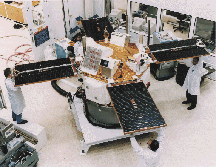Many science teams, such as the ACE project pictured here, are
repositioning satellites so they won't be damaged in the meteor
shower.
Click on image for full size
Image courtesy of NASA
Meteor Shower May Cause Problem with Spacecraft
News story originally written on November 15, 1998
The
Leonids meteor shower is expected to
peak on November 17th, 1998. The meteors may cause problems with many
different satellites in orbit. The meteors could break the outside skin
of the satellites or cause problems with sensitive electronics.
Only a small fraction of the meteors are big enough to break through the
skin of a satellite. The chances of this type of problem are very small.
The biggest threat are ionized particles created by very small meteors
colliding with a satellite. Even though the meteors can't damage a
satellite's hull, they can create an electric field that can damage
sensitive electronics inside the satellite.
Some projects such as the
Advanced
Composition Explorer will power-down the instruments on their
satellites. Scientists believe that this will prevent the meteors from
doing any damage. The satellites may also be reoriented to shield
sensitive equipment or to present the smallest profile toward the meteors.
You might also be interested in:

It was another exciting and frustrating year for the space science program. It seemed that every step forward led to one backwards. Either way, NASA led the way to a great century of discovery. Unfortunately,
...more
The Space Shuttle Discovery lifted off from Kennedy Space Center on October 29th at 2:19 p.m. EST. The weather was great as Discovery took 8 1/2 minutes to reach orbit. This was the United States' 123rd
...more
A moon was discovered orbiting the asteroid, Eugenia. This is only the second time in history that a satellite has been seen circling an asteroid. A special mirror allowed scientists to find the moon
...more
Will Russia ever put the service module for the International Space Station in space? NASA officials want an answer from the Russian government. The necessary service module is currently waiting to be
...more
A coronal mass ejection (CME) happened on the Sun early last month. The material that was thrown out from this explosion passed the ACE spacecraft. The SWICS instrument on ACE has produced a new and very
...more
J.S. Maini of the Canadian Forest Service called forests the "heart and lungs of the world." This is because forests filter air and water pollution, absorb carbon dioxide, release oxygen, and maintain
...more
In late April through mid-May 2002, all five naked-eye planets are visible at the same time in the night sky! This is includes Mercury which is generally very hard to see. You won't want to miss this!
...more















